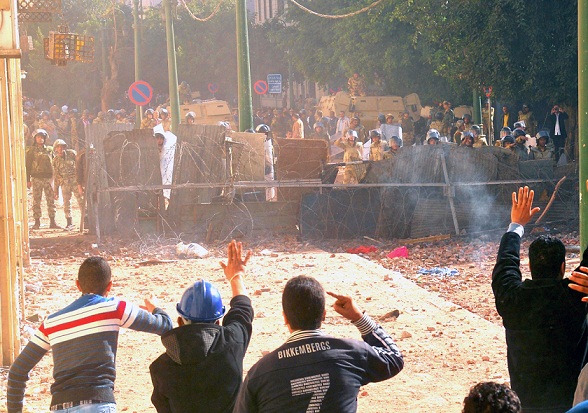A single word can evoke different reactions, interpretations and feelings in different people, a fact amply demonstrated at the ongoing exhibition at Darb 1718 Contemporary Art and Culture Center.
Centered on the word “SPLIT,” the exhibition showcases six artists of three different nationalities — Egypt, Cyprus and Tunisia. The outcome is some interesting elucidation on the word SPLIT, from the obvious to the more subtle.
Who would have thought that a park bench and bird control spikes can be put together to create an exhibit that talks about the opposition or the split in the civilized society?
Nadia Kaabi from Tunisia has mounted sharp metallic bird spikes on the wooden slates of a park bench to show the fundamental contradiction or separation that occurs through the loss of functionality of the park bench.
“I think it’s an interesting point that societies which consider themselves as open-minded and free invent these kind of anti-settlement control systems,” Kaabi told Daily News Egypt. “I wanted to express my feeling of protest about the idea of wanting to control everything, even the most free elements in nature, i.e. birds,” says Kaabi, explaining the inspiration for her work, while also adding another dimension to her exhibit.
The world map has been re-drawn several times as wars and hostile occupations have changed the geographical boundaries of nations. The casualty of the political and military ambitions of the powerful nations is usually the mute civilian population. Theopisti Stylianou’s photos show mannequins in shops on both sides of the divided Cypriot capital city of Nicosia. These mannequins bear a mute testimony to the events that led to Turkey occupying the northern part of Cyprus and the continuation of the dominance.
Cypriot artist Melina Nicolaides’ unique installation consists of seven pieces that are alike in form; the top and bottom parts being held together with metal screws. Aptly titled “Trambala,” the Cypriot word for a child’s rocking toy, the installation symbolizes the instability of the island nation of Cyprus, while subtly alluding to the image of the country being split into half by the Turkish occupation.
The seven pieces colored with lustrous industrial paint, are representative of the seven main players in the Cyprus issue, which according to Nicolaides, have been instrumental in shaping the island nation’s recent history. Though beginning with the predominant color copper — the metal that was given its name by the island due to the fact that it was found in abundance there — the visual balance of the pieces is disrupted by the black paint on the upper part of the central piece and the faded hues of its lower part.
“This is representative of that dangerous moment when you are so pressured and so dizzy that you have lost yourself,” Nicolaides told Daily News Egypt. The artist’s inherent optimism explains her choice of the color copper again for the pieces following thereafter, thus signifying hope and change.
This, of course, is the artistic interpretation for Trambala but an Egyptian customs official responsible for its ‘clearance,’ has unwittingly added another dimension to the artwork by marking the pieces with his signature in green. This act highlights the lack of sensitization in people who deal with art forms in the course of their work. It also raises the important question of what is considered art and who considers it so.
Rather than being disheartened by this irreversible scarring of her artistic work, Nicolaides bravely calls the Trambala her “uniquely Egyptian piece.”
The striking mixed media paintings by Amr El-Kafrawy seek to reflect the conflict when the outward appearances are at odds with the real identity of a person.
His portraits of women have been arranged to reflect the growing incidence of women taking the veil. Progressively, more and more of the woman is smothered behind the fabric; yet this fails to curb her spirit. And thus it leads to a situation where her actions seem to contradict the implications of her attire.
The video installation by Tunisian artist Nicene Kossentini seeks to show that confusion reigns supreme when the mind does not work in tandem with the limbs. The hands and feet of the body are separated or split by a white space. The white space is used to create the image of a body devoid of all stereotypes and shorn of all identity.
A significant factor that enhances the appreciation and enjoyment of this exhibition is the insightful notes accompanying the displayed work. You can observe the work, interpret it your way and then check the artist’s note to see what the ‘split’ is all about.
“Split” runs till May 22 at the Darb Center: Kasr El Sham Street, Al Fakhareen, Old Cairo.
Š Θ
Θ
#

#
An Egyptian customs official responsible for Trambala’s ‘clearance,’ has added another dimension to the artwork by marking the pieces with his signature in green.
#


